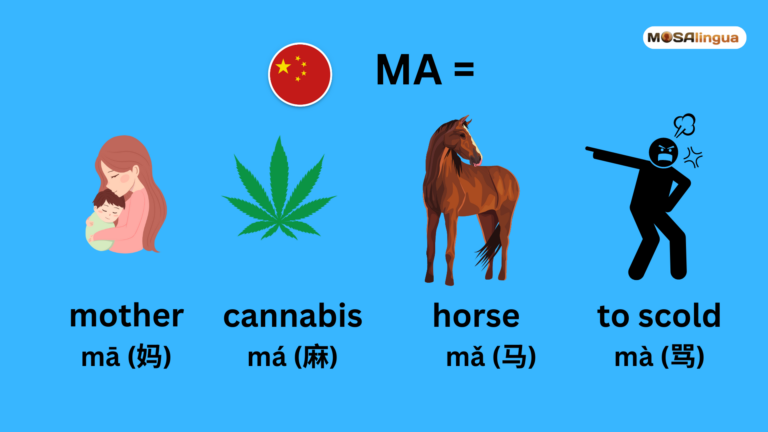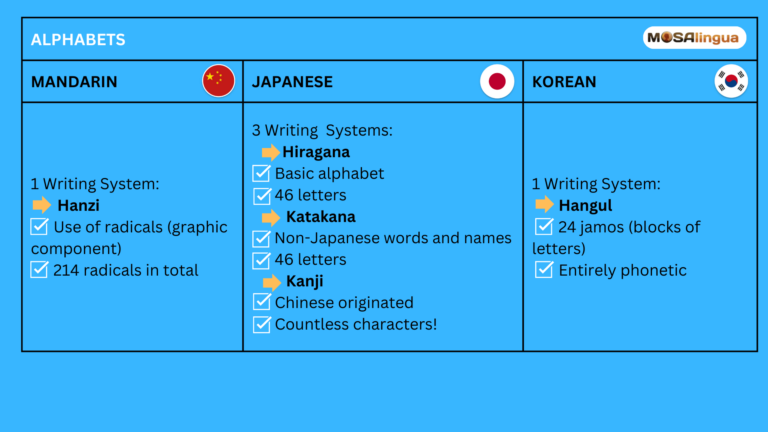Chinese, Japanese, and Korean are three of the most commonly learned Asian languages, and they’re among some of the most challenging languages to learn. Learning an East Asian language
can give you access not only to opportunities in some of the world’s largest economies but also to incredibly rich traditions in terms of history, culture, and arts. Join our instructor Lisa-Joy to take a closer look at
these three popular Asian languages. She’ll compare different aspects of each (pronunciation, vocabulary, reading and writing systems, and grammar) to determine which one is the most difficult!

Most difficult language: Chinese, Japanese, or Korean?
Let’s face it, learning an Asian language is significantly different from learning a language with Latin roots, such as French or Italian. So I think it’s fair to say that, especially for Western learners, some aspects of learning an Asian language will require a little bit more time to master.
Chinese, Japanese, and Korean pronunciation and vocab
You can listen to each of these three languages spoken by native speakers in the video below. This will help you conceptualize some of the differences in their pronunciation.
Mandarin
Mandarin Chinese is a fascinating and rich language, and it’s notoriously difficult to pronounce correctly. This is because it is a tonal language. It has four tones, which means a syllable can have four different meanings based on the tone used. There are also quite a few sounds that have no equivalent in any Western languages. So you’ll need to practice these sounds extra!
Let’s take the syllable ma as an example of tonality. This syllable has four different pronunciations and four different meanings…so imagine the confusion there could be if you pronounce this syllable wrong!
Japanese
On the other hand, Japanese uses a short range of syllables and is without tones. So once you get a grip on how these syllables work together, pronouncing words in Japanese just kind of feels like
slotting Lego blocks together. It’s quite hard to get wrong, and minor pronunciation mistakes are usually still understandable.
Korean
In pronunciation, Korean falls somewhere between Japanese and Chinese. It doesn’t use tones, but the sounds are a little harder to grasp than the relatively easy sounds of Japanese.
Level of difficulty
Did you know that Japanese and Korean both have Chinese roots? This means that there’s a lot of similar vocabulary among these three languages. That’s why, if you already know one of these three languages, you’ll have a massive head-start for learning another.
But out of these three, Japanese is the one that has the most English cognates: 22%! Korean has 15%, and Chinese has very few cognates with English.
Chinese, Japanese, and Korean alphabets
Mandarin
The alphabet is the hardest aspect of learning this language. Although this language uses only one writing system called “hanzi,” it is made up of many complicated symbols that seem like pictures more than an alphabet. These symbols are Chinese characters and they each represent a meaning such as a word, a sound, or a grammatical function.
The writing system for this language is based on radicals. A radical is just like a graphic component. You’ll need to learn 214 radicals and the correct order of placing this collection of strokes to make up one character. With practice, time, and effort, you can eventually learn how to read and write in this language.
Japanese
The Japanese reading and writing system uses not only one or two but three essential alphabets! There are hiragana and katakana which both have 46 letters in total, and kanji which has thousands of letters!
I know it sounds confusing that a language needs three different alphabets, but the differences between these alphabets are so clear that it’s not as hard as many people think. If you’re interested in learning more about reading and writing in Japanese, then I recommend you check out my colleague Sarah’s article and video on this topic.
Korean
Last up, we have hangul, the Korean writing system. Yes – Korean only has one writing system! Hangul combines the Korean word han (한) – meaning “great” – and gul (글) – meaning “script.” However, the word “han” is also used to refer to “Korea” in general, so the name can also be translated to “Korean script.”
The Korean alphabet is one of the easiest alphabets in the world to learn. There is even a consensus that says it is the most logical and easiest writing system out there. It only has 24 letters, divided into 14 consonants and 10 vowels. It’s entirely phonetic, so once you’ve learned the symbol to match the sound, you can technically read any Korean word. Believe it or not, you can learn this alphabet in just a few hours.
Here’s a table that summarizes the differences between the Chinese, Japanese, and Korean alphabets:
Chinese, Japanese, and Korean grammar
Mandarin
If Mandarin Chinese was at the top of the list in terms of difficulty with its alphabet, it balances out a bit here. We can say that Chinese grammar is the easiest out of the three languages. In Mandarin, there are no verb tenses. Instead, specific words indicate the past, the future, and the present tenses. On top of that, verbs, nouns, and adjectives don’t have to agree with one another, and there is no such thing as singular and plural in Chinese.
Japanese
Japanese grammar is also very different from English, and we could say that Japanese conjugation is quite limited compared to Western languages. There is no gender or number agreement, and the sentence structure is very flexible. There are a couple of things that are a bit confusing: the verb goes at the end, and particles are used to indicate the function of a word in a sentence.
Here’s an example of a simple English sentence translated into Japanese, so you can see how much they differ:
I gave bread to him → 私は彼にパンをあげた (watashiwa kareni pan o ageta) → I – him – to – bread – gave
Korean
As mentioned earlier, Korean has the simplest alphabet. However, its grammar is the toughest of the three languages. Korean is what’s known as an “agglutinative” language, meaning words are often stuck together to create new meanings. This can make individual words trickier to figure out at a glance. Korean also uses a lot of connectors to form sentences, and this can take quite a lot of practice to start using naturally.
Conclusion
To wrap all this up, let’s have a look at which of these three languages is considered the most difficult. According to our criteria, Chinese takes the prize, though both Korean and Japanese come in close behind!
And please, bear in mind that this is our own opinion here at MosaLingua. Other learners might have a different opinion and experience with learning these languages. At the end of the day, learning any language
is always a challenge…no matter how similar it may be to your native language!
WATCH: Chinese, Japanese, or Korean: Which is the Most Difficult Language?
You can also watch Lisa-Joy’s video, which covers all the points mentioned above. You can also hear examples of each of these three languages spoken by native speakers. It’s in English, but subtitles are available in several languages. Just click on the settings gear in the bottom right corner.
Don’t forget to subscribe to our YouTube channel!
Go further
If you liked this article, you might also enjoy:
Related posts:
Want to start improving your language skills today?
Start learning a new language today

Good news: we can help!
More good news: you can get started for free! Start your free trial now and for the next 15 days, take advantage of the most effective language learning method on the market!
Vocabulary flashcards, videos with subtitles, audiobooks, articles adapted to your level – with MosaLingua Premium (Web & Mobile), you’ll have access to all this and more. Get started right now. It’s free—and risk-free—to try!






![How to Say Colors in Spanish and Describe Every Shade in the Rainbow [VIDEO]](https://www.mosalingua.com/en/files/2020/05/colors-in-spanish-mosalingua-300x150.jpg)
Comments